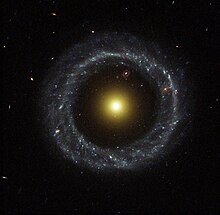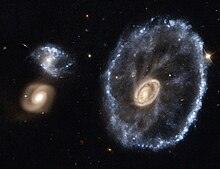Galaktyka pierścieniowa

Galaktyka pierścieniowa – galaktyka zbudowana z jądra oraz otaczającego je pierścienia. Pierścień ten złożony jest z młodych, masywnych, błękitnych gwiazd. Obszar między jądrem a pierścieniem zawiera niewielkie ilości gwiazd. Astronomowie podejrzewają, że galaktyki pierścieniowe powstają, gdy duża galaktyka spiralna zderzy się z mniejszą.
Galaktyką pierścieniową jest np. Galaktyka Koło Wozu w gwiazdozbiorze Rzeźbiarza.
Zobacz też
- Obiekt Hoaga – pierwsza odkryta galaktyka pierścieniowa
- AM 0644-741
Media użyte na tej stronie
A nearly perfect ring of hot, blue stars pinwheels about the yellow nucleus of an unusual ring galaxy known as Hoag's Object. This image from NASA's Hubble Space Telescope captures a face-on view of the galaxy's ring of stars, revealing more detail than any existing photo of this object. The image may help astronomers unravel clues on how such strange objects form.
The entire galaxy is about 120,000 light-years wide, which is slightly larger than our Milky Way Galaxy. The blue ring, which is dominated by clusters of young, massive stars, contrasts sharply with the yellow nucleus of mostly older stars. What appears to be a "gap" separating the two stellar populations may actually contain some star clusters that are almost too faint to see. Curiously, an object that bears an uncanny resemblance to Hoag's Object can be seen in the gap at the one o'clock position. The object is probably a background ring galaxy.
Ring-shaped galaxies can form in several different ways. One possible scenario is through a collision with another galaxy. Sometimes the second galaxy speeds through the first, leaving a "splash" of star formation. But in Hoag's Object there is no sign of the second galaxy, which leads to the suspicion that the blue ring of stars may be the shredded remains of a galaxy that passed nearby. Some astronomers estimate that the encounter occurred about 2 to 3 billion years ago.
This unusual galaxy was discovered in 1950 by astronomer Art Hoag. Hoag thought the smoke-ring-like object resembled a planetary nebula, the glowing remains of a Sun-like star. But he quickly discounted that possibility, suggesting that the mysterious object was most likely a galaxy. Observations in the 1970s confirmed this prediction, though many of the details of Hoag's galaxy remain a mystery.
The galaxy is 600 million light-years away in the constellation Serpens. The Wide Field and Planetary Camera 2 took this image on July 9, 2001.An image of the Cartwheel Galaxy taken with the NASA/ESA Hubble Space Telescope has been reprocessed using the latest techniques to mark the closure of the Space Telescope European Coordination Facility (ST-ECF), based near Munich in Germany, and to celebrate its achievements in supporting Hubble science in Europe over the past 26 years.
Astronomer Bob Fosbury, who is stepping down as Head of the ST-ECF, was responsible for much of the early research into the Cartwheel Galaxy along with the late Tim Hawarden — including giving the object its very apposite name — and so this image was selected as a fitting tribute. The object was first spotted on wide-field images from the UK Schmidt telescope and then studied in detail using the Anglo-Australian Telescope.
Lying about 500 million light-years away in the constellation of Sculptor, the cartwheel shape of this galaxy is the result of a violent galactic collision. A smaller galaxy has passed right through a large disc galaxy and produced shock waves that swept up gas and dust — much like the ripples produced when a stone is dropped into a lake — and sparked regions of intense star formation (appearing blue). The outermost ring of the galaxy, which is 1.5 times the size of our Milky Way, marks the shock wave’s leading edge. This object is one of the most dramatic examples of the small class of ring galaxies.
This image was produced after Hubble data was reprocessed using the free open source software FITS Liberator 3, which was developed at the ST-ECF. Careful use of this widely used state-of-the-art tool on the original Hubble observations of the Cartwheel Galaxy has brought out more detail in the image than ever before.
Although the ST-ECF is closing, ESA’s mission to bring amazing Hubble discoveries to the public will be unaffected, with Hubblecasts, press and photo releases, and Hubble Pictures of the Week continuing to be regularly posted on spacetelescope.org

